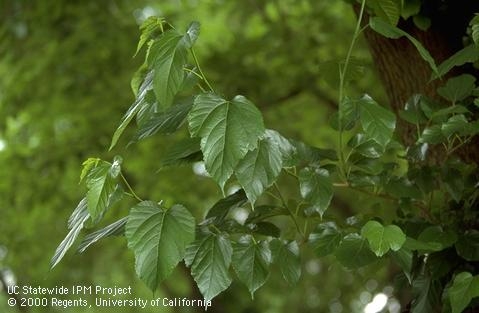Fruitless Mulberry Tree
Advice for the Home Gardener from the Help Desk of the
UC Master Gardener Program of Contra Costa County
Client's Request: Just moved into this about 50 year old house. I have a Fruitless Mulberry in my front yard that isn't looking too good. I don't think the prior owners took very good care of it. I"ve already pruned back most of the overgrwon branches and I'm wondering what I should do to get this tree looking healthy again. Please advise.
MGCC Help Desk Respons Thank you for contacting the UC Master Gardener Program Help Desk with your question about your fruitless mulberry tree.

Fruitless mulberries are moderately drought-tolerant, but they can sometimes lose leaves in prolonged dry weather. We suspect this might be the case with yours since our summer and fall have been hotter than normal.
Our recommendation at this point is not to worry unless you notice increased branch die off or the appearance of other unusual symptoms that could indicate disease or pests. It's good that you have already pruned your tree so be sure to give good irrigation until the rains start this fall and give your tree good cultural care as noted above.
The link below gives you additional information about growing fruitless mulberry and pests and diseases that they can suffer from:http://ipm.ucanr.edu/PMG/GARDEN/PLANTS/mulberry.html
Please let us know if you have any additional questions!
Help Desk of the UC Master Gardener Program of Contra Costa County (SLH)
HOrT COCO Editor's Addendum: Having lived with and cared for several Fruitless Mulberries the past 50+ years, I have a few comments to add to the great response above. First, you can almost tell the age of a subdivision by the tree planted in front. My subdivision built in the late 1960s once had a Fruitless Mulberry in the front yard of every house, except for mine. Isaid that I would take the tree. but I wanted to plant it on the east side of the house to block the summer sun. In that the tree is deciduous, I wanted the winter sun, but not the blazing summer sun. The tree is a great shade tree with its big leaves and rapid spring growth, but a lawn tree it isn't. Shallow roots are a pain from this tree of which I have first hand experience when I hand dug the foundation for a kitchen addition. The rock was easy compared to all the roots I encountered and removed. Of the 7 houses on my court, 4 front yard mulberrys still survive and are in good health without much water, but all of us will be raking leaves for the next month or so. Some neighbors prune early to take the leaves down at the same time. Pruning now isn't recommended for the tree's health, but it is a tough tree, and all the survivng trees are healthy and still growing. However, overall most of the front yard mulberrys in the subdivision are now long gone, usually to reduce homeowner (now mostly gardener) maintenance.
Note: The UC Master Gardeners Program of Contra Costa's Help Desk is available year-round to answer your gardening questions. Except for a few holidays, we're open every week, Monday through Thursday for walk-ins from 9:00 am to Noon at 75 Santa Barbara Road, 2d Floor, Pleasant Hill, CA 94523. We can also be reached via telephone: (925)646-6586, email: ccmg@ucanr.edu, or on the web at http://ccmg.ucanr.edu/Ask_Us/ MGCC Blogs can be found at http://ccmg.ucanr.edu/HortCoCo/ You can also subscribe to the Blog (//ucanr.edu/blogs/CCMGBlog/).
Comments:
However, I can give you some recommendations to get you started on what you might do to "recover" your fruitless, overgrown fig tree.
I would suggest that you become informed about what cultural care a fig tree needs to be healthy. Generally, in my limited experience, fig trees are quite hardy, but I do not know your location and/or the conditions of where the fig is growing, e.g. location, age (guess?), irrigation, sun, summer and winter temperatures, etc. I would also suggest you look at the UCANR page on Backyard Orchard Figs, especially the links at the bottom of the page at http://homeorchard.ucanr.edu/Fruits_&_Nuts/Fig/
I find the California Rare Fruit Growers link http://www.crfg.org/pubs/ff/fig.html especially informative on what you might need to do to rehab the fig. Finally, with that information in hand and you still want to discuss your fig, I would suggest you contact the Help Desk at our UC Master Gardeners Program Help Desk... details on how to do that can be found on their home page at http://ccmg.ucanr.edu/Ask_Us/
Good luck... considering the neighbor's growing and producing fig tree hanging over my fence from her yard grows and produces with almost minimal care, I believe with some appropriate pruning and improved cultural care (irrigation, fertilizer, etc.) you should be able to rehab your tree successfully.
CHEERS, HOrT COCO editor
Posted by Gordon Lake on November 6, 2017 at 3:32 PM